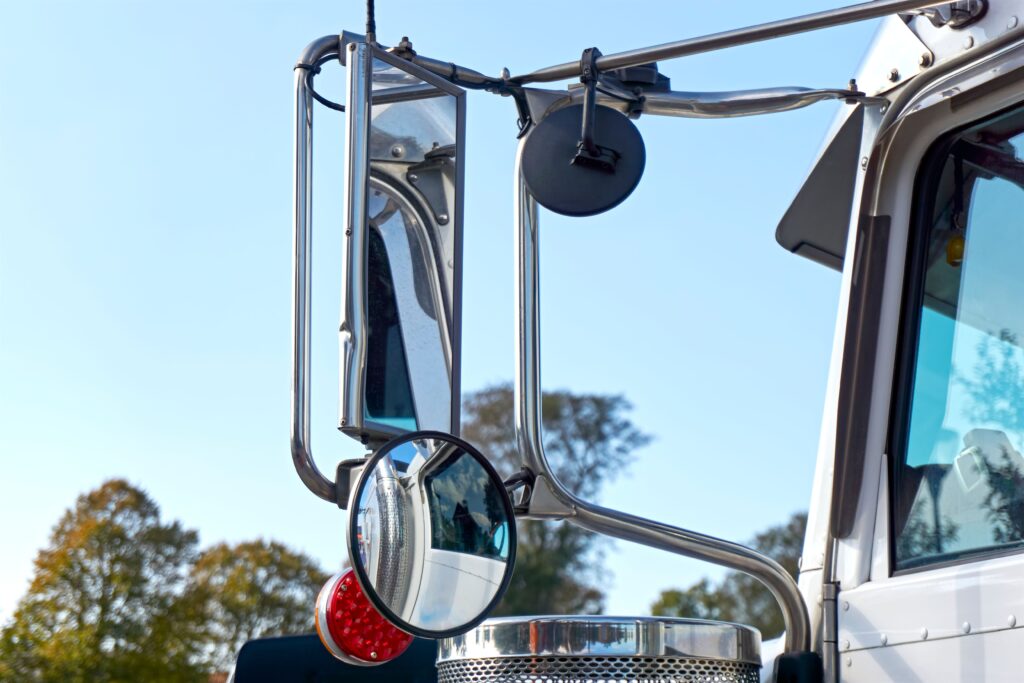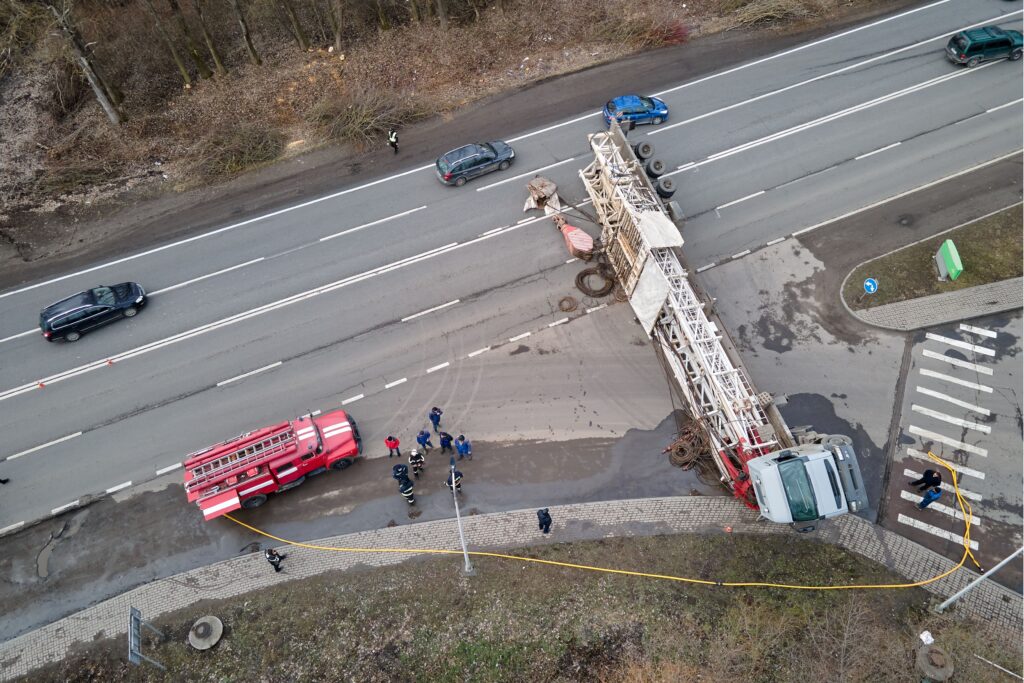Spotting trucking hazards on the road requires your full attention and quick responses to steer clear of potential dangers. Keep a lookout for blind spots where vehicles can disappear from a truck driver’s view, leading to accidents. Avoid lingering in these blind spots during lane changes and signal your intentions clearly. Be on the alert for signs of fatigued drivers like drifting between lanes or erratic speed changes.
Understanding braking distance based on speed, road conditions, tire grip, weight of the vehicle, and driver reaction time is essential for preventing accidents. By adapting to poor weather conditions with reduced visibility, decreased traction, slower speeds, and increased stopping distances, you enhance road safety. Stay vigilant to the road ahead for a safer journey.
Recognizing Blind Spots

When driving near trucks, it’s important to understand their blind spots to guarantee your safety on the road. These blind spots are areas where the truck driver’s visibility is limited, so avoid lingering in them to prevent accidents. Remember to give trucks plenty of space and signal clearly when changing lanes to stay out of their blind spots.
Blind Spot Risks
To navigate safely around trucks on the road, recognizing and understanding blind spots is essential for all drivers. Being aware of the blind spot risks can help you avoid potential accidents and guarantee a safer driving experience. Here are some key points to ponder:
- Blind spots are substantial areas where other vehicles can disappear from the truck driver’s view.
- Vehicles in blind spots can lead to unintentional collisions and accidents on the road.
- Increased vigilance and awareness of truck blind spots are vital for preventing accidents.
- Careful maneuvering around trucks can help in avoiding potential collisions caused by blind spots.
- Awareness of blind spots is crucial for safe driving and can greatly reduce the risk of accidents.
Stay alert and mindful of blind spots to stay safe on the road!
Safe Lane Changing
Moving safely around trucks requires a vital awareness of blind spots to guarantee smooth lane changes and prevent potential collisions. Truck blind spots, especially larger on the right side and extending behind the truck, pose significant risks during lane changes. To stay safe, avoid lingering in these blind spots and make good use of your mirrors. When changing lanes around trucks, always signal your intentions clearly. Being aware of blind spots is essential for all road users to navigate around trucks safely. By understanding and respecting these blind spots, you contribute to a safer road environment for everyone. Remember, a moment of caution can prevent a lifetime of regret. Stay vigilant, stay safe.
Identifying Fatigued Drivers

You need to be vigilant on the road to spot signs of fatigued truck drivers, such as drifting between lanes, frequent yawning, or missing road signs. Recognizing these indicators can help you stay safe and alert around trucks facing driver fatigue. Remember, identifying fatigued drivers is essential for preventing accidents and ensuring road safety for everyone.
Signs of Driver Fatigue
Driver fatigue poses a significant yet often overlooked risk for truck drivers on the road, impairing their reaction time and decision-making skills. Here are some signs to help you identify fatigued drivers:
- Drifting between lanes or onto rumble strips.
- Yawning or rubbing eyes frequently.
- Difficulty focusing or keeping eyes open.
- Missing exits or traffic signs.
- Erratic speed changes or tailgating.
Recognizing these signs is vital for your safety and the safety of others on the road. If you notice these behaviors in yourself or other drivers, take action to prevent accidents. Remember, staying alert and taking breaks when needed can make a significant difference in preventing accidents caused by driver fatigue.
Understanding Braking Distance

You’re cruising down the highway in your truck, but do you know how braking distance can affect your ability to stop in time? Understanding the factors that influence braking distance, such as speed, road conditions, and vehicle weight, is essential for safe driving. Maintaining safe following distances and adjusting your speed accordingly can help you react effectively to potential hazards on the road.
Braking Distance Factors
When considering the factors that influence braking distance, one must understand the critical role that vehicle speed, road conditions, tire grip, weight of the vehicle, and driver reaction time play in determining the distance a vehicle travels from braking initiation to a complete stop.
- Vehicle Speed: Higher speeds notably increase braking distance, necessitating more time and distance to stop safely.
- Road Conditions: Poor road conditions such as wet or icy surfaces can dramatically extend braking distance, making it challenging to stop promptly.
- Tire Grip: The grip of the tires on the road affects braking distance, with better grip allowing for shorter stopping distances.
- Weight of the Vehicle: Heavier vehicles require more distance to stop compared to lighter vehicles due to the increased momentum.
- Driver Reaction Time: A quick reaction time is pivotal for reducing braking distance and preventing accidents on the road.
Safe Following Distances
Considering the critical factors influencing braking distance, understanding safe following distances is paramount for road safety, particularly when sharing the road with trucks. Braking distance, the distance a vehicle travels from applying the brakes until it stops, is essential to grasp when driving near trucks. Trucks, due to their size and weight, require more distance to stop compared to smaller vehicles. Maintaining a safe following distance provides the necessary time to react and stop safely during emergencies. By comprehending braking distance, drivers can anticipate how quickly trucks can stop, reducing the risk of rear-end collisions. Remember, giving trucks enough space on the road not only safeguards your safety but also contributes to a more secure driving environment for everyone.
Avoiding Lane Drifting

You know how unsettling it can be when a truck starts drifting out of its lane unexpectedly, putting everyone at risk. Signs of drowsiness or driver distractions can contribute to this risky behavior, making it important to stay alert on the road. Remember, focusing on the road ahead and maintaining safe distances can help you avoid potential accidents caused by lane drifting.
Signs of Drowsiness
During long hauls, spotting signs of drowsiness like frequent yawning and heavy eyelids can help truck drivers avoid dangerous lane drifting on the road. Here are some key tips to keep in mind:
- Take regular breaks: Rest stops can help you stay alert and refreshed.
- Stay hydrated: Dehydration can contribute to fatigue, so drink water regularly.
- Get enough rest: Essential sleep is crucial for maintaining focus while driving.
- Avoid heavy meals: Large, heavy meals can make you feel sluggish and less alert.
- Use caffeine wisely: While it can provide a temporary boost, don’t rely on it as a substitute for rest.
Monitor your body’s signals and prioritize safety by addressing drowsiness promptly to prevent accidents.
Driver Distractions
To prevent lane drifting caused by driver distractions, maintaining focused attention on the road is essential for safe and controlled driving. Driver distractions such as using phones, eating, or adjusting controls can lead to lane drifting, a common hazard resulting from inattention or drowsiness while driving. Avoiding lane drifting requires staying focused on the road and maintaining proper lane discipline. Some vehicles are equipped with lane departure warning systems that can help alert drivers if they start drifting out of their lane. Lane drifting poses a significant risk of collisions, especially on highways or at high speeds.
| Driver Distractions | Effects | Prevention |
|---|---|---|
| Using phones | Lane drifting | Avoid phone use |
| Eating | Inattention | Eat before driving |
| Adjusting controls | Drowsiness | Set controls before driving |
Dealing With Poor Weather Conditions

Traveling through inclement weather presents truck drivers with a myriad of challenges that demand heightened vigilance and adaptability on the road. When faced with poor weather conditions, consider the following to ensure your safety and the safety of others:
- Reduced Visibility: Poor weather conditions like rain, snow, and fog can greatly diminish visibility, making it harder to see other vehicles on the road.
- Decreased Traction: Wet or icy roads during poor weather can diminish traction, increasing the risk of skidding or losing control of your truck.
- Slower Speeds: Adapting your speed to match the road conditions is vital to prevent accidents caused by reduced traction and visibility.
- Increased Stopping Distance: Poor weather conditions necessitate a longer stopping distance, so maintain a safe distance from other vehicles to account for this.
- Use of Lights: Properly functioning headlights and taillights are vital in low visibility conditions to ensure other drivers can see your truck clearly.
When dealing with poor weather conditions, remember that safety should always be your top priority. Adjust your driving techniques, maintain a safe speed, and be prepared to react quickly to changing road conditions to navigate through inclement weather safely.
Conclusion
Now that you’re equipped with the knowledge to spot trucking hazards on the road, remember that 33% of truck accidents are caused by lane drifting. Stay vigilant, watch out for blind spots, and be aware of fatigued drivers. Understanding braking distance and being prepared for poor weather conditions are key to staying safe on the road. By being proactive and cautious, you can navigate these hidden dangers with confidence and guarantee a smooth journey ahead.
One of the deadliest road hazards can be aggressive drivers, check out how to spot and avoid aggressive drivers on our other post!










